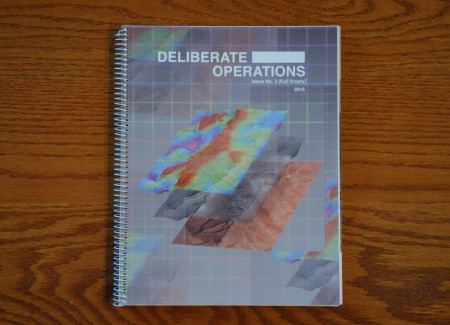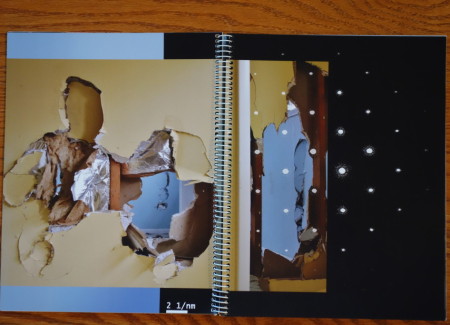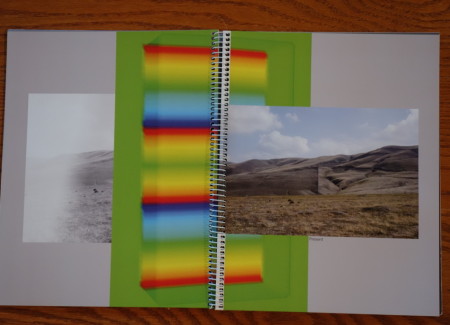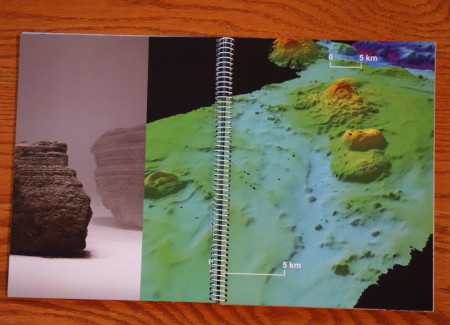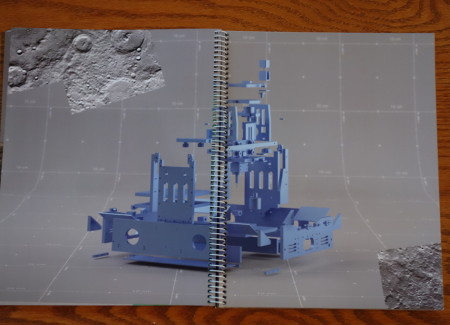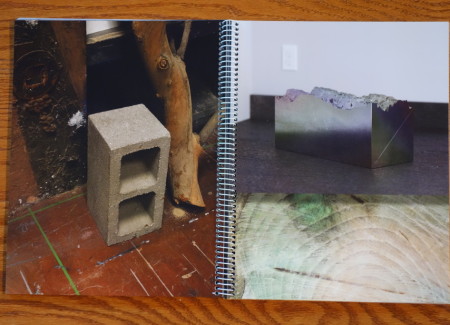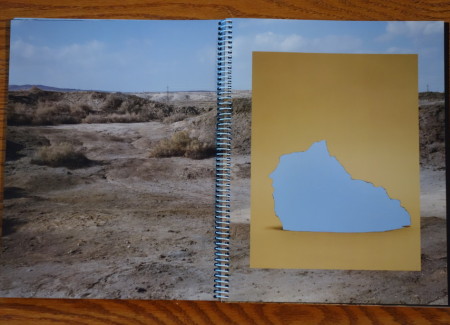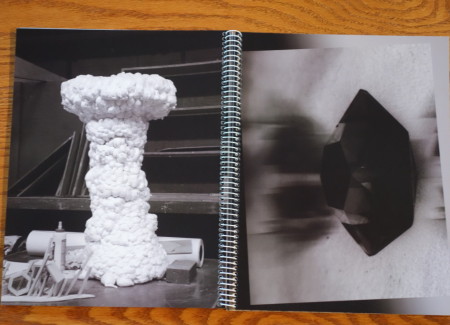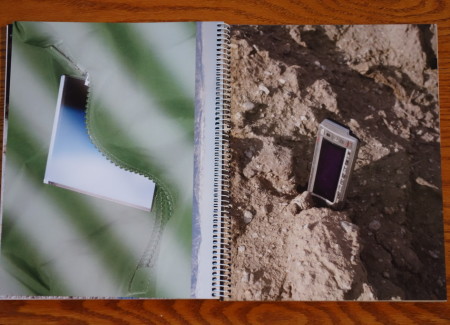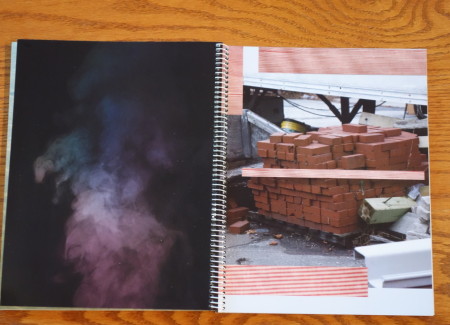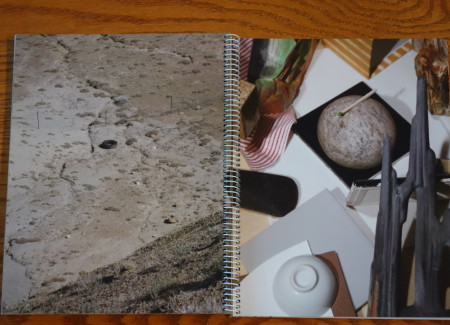JTF (Just the facts): Self-published in 2015 by Everything is Collective (here). Wire bound, 166 pages, with color and black and white reproductions (an exact tally is complicated by the overlapping of imagery). Includes an introduction and essay by the artists. In an edition of 200, and priced at $35. Everything is Collective is Jason Lukas, Zachary Norman, and Aaron Hegert. (Cover and spread shots below.)
Comments/Context: Deliberate Operations 3 [Full Empty] is the most mystifying and strange photobook I have encountered this year, and even though it has left me stumped for the better part of several months now, its unconventional brilliance has undeniably started to grow on me. The more time I spend immersed in its puzzlingly intractable environment, the more I am convinced that it represents something new and innovative, an iterative step forward in how photography can be used to create conceptual structure. And while that pronouncement may sound painfully obtuse and abstract, part of what is going on here is a rethinking of how photographs can interact with each other (especially digitally) to describe something in between the pictures themselves. It’s as if a brand new language has been developed and employed here, one that uses photographs in complex and fluid new relationships. In this way, this photobook is almost like an artifact from the future, and back here in the present, we don’t yet have all the intellectual tools to entirely decode its message.
While the history of digital photography since the advent of Photoshop has not yet been comprehensively and authoritatively written, it is clear that there have been multiple “generations” of ideas, methods, and approaches that have evolved since the early 1990s, each one building on the previous. Software-driven manipulation and retouching have gone through several distinct phases, as has net-enabled appropriation, particularly in the area of reuse of commercial imagery. For those artists/photographers “born” in the digital era (and not inherently bound by the rules of the previous analog age), a tightly-coupled Internet echo chamber has been their primary artistic environment, where the innovations of one artist are immediately absorbed into the larger body of ideas, quickly mastered, and ultimately transformed into the next set of end results. Even the many dead ends and blind alleys along the way have added to the collective forward momentum, as they too have been incorporated into the knowledge of what works and what doesn’t. While not as fast as Moore’s Law semiconductor generations (roughly 18 months), when the dust settles, these digital photography generations will likely end up measuring only 2 or 3 years between iterative artistic jumps.
This forward thrust has led to a networked set of overlapping influences and aesthetic commonalties that reappear across artists, some of which can be found in the work of Everything is Collective. In certain images in this photobook, there are derivative remnants of Lucas Blalock’s Photoshop smudging, Jordan Tate’s isolated scientific repurposing, Roe Ethridge’s commercial recalibration, Joshua Citarella’s digitally constructed forms, and Christopher Williams’ measured products, among others. But these references are like the inherited traits of an ancestor – they definitively show signs of common lineage, but they have been recombined here in such a way as to generate something entirely different. The fact that Everything is Collective is actually three people (Jason Lukas, Zachary Norman, and Aaron Hegart) makes this mixing of aesthetics even more difficult to trace, leading to something like digital anonymity.
The pictures in this photobook interweave the conventionally “taken” and the appropriated with a complete lack of overt differentiation, often combining divergent images on or across the same spread. While categorization of these images seems deliberately impeded, the works here include hyper-precise straight photographs (both still lifes and found arrangements), digitally modified imagery, stitched together Mars/moon panoramas, 3D renderings and topographical maps, archival footage of scientific laboratories, grainy aerials, and micro/nanophotography, all sequenced into rhythms of form and pattern and/or mashed up into oddball hybrids. Scale is entirely malleable (blithely ranging from a few nanometers to a few kilometers) and quasi-scientific measurement seems to be constantly occurring in various guises (from tree rings and rulers to highly advanced spectrometers and color maps). Chunky rocks and machine edged metals offer opposing surface characteristics, which are then examined, mapped and covered,becoming cratered landscapes, rocky hills, foam blobs, and graphene sheets. These images and fragments are then recombined in all directions, often layered across and over each other rather than set neatly inside a straight-on rectangle. As the pages turn, we move from quantum dots to Styrofoam balls to bright lights in the sky with action-at-a-distance immediacy, equally mesmerized by the mechanisms of metallic crystals, 3D printed detailing, and the slats of a snow fence.
My first (and I must admit dismissive) reaction to this photobook was that it felt a little like a 21st century digital version of Mike Mandel and Larry Sultan’s Evidence – incomprehensible pictures, vaguely scientific/”professional”, open to interpretation – but that’s an overly simplistic comparison, given the yawning distance in time between the two. There are also parallels to Anouk Kruithof’s recent cut-and-paste rethinking of Evidence in the context of corporate Instagram accounts, but ultimately Everything is Collective seems to be doing something more inherently structural. Their photobook is a deliberate move away from the idea of a photograph as a single instantiation image/object and toward a mindset where an image is something much more changeable and the digital interaction between images is actually a process itself or perhaps a language.
A shimmery surface not unlike crumpled aluminum foil is many things at once in this book, in undulating waves – a surface to be mapped, a visual reminder of close-up rock erosions, a contrasting background for something impossibly perfect, a light/dark optical illusion, an interrupter of reality, a cut away echo of moonscapes and desert hills. The same can be said of chunks of rock, fuzzy geometric solids, scientific machinery, mapping and measuring tools, and architectural/structural elements (bricks, girders, cinder blocks) – they repeat and reform in new combinations, simultaneously referring to what came before, undercutting that previous experience, and becoming something else. In the science of nanotechology, “self-assembly” is a term for a process that emerges natively from the bottom-up, rather than one that is consciously imposed from the top-down; it’s a perfect metaphor for Everything is Collective’s view of photography – their visual building blocks seem to be swimming around and interacting with each other on their own terms, organizing (and reorganizing) themselves based on an unseen set of constraints and foundation relationships. What’s surprising about these images is that they never feel random, deadpan ironic, or archly clever, however skew or tangential the connections and references might seem; there’s always an inner logic at work, an invisible system tying the disparate elements together.
What’s left me particularly intrigued are the structural implications of this photobook. Everything is Collective’s vision of photography is inherently non-linear, multi-dimensional, and many-to-many, and yet they have used a linear, two-dimensional, one-to-one medium (the photobook) to make that vision physical and to disseminate it to others. That doesn’t seem sustainable. Why not just force us to step into the digital world, where a matrixed architecture could be employed? Then our collective acceptance of an inundating “sea of images” could be matched to both their systematic reconstruction of the underlying rules that connect those pictures and their aesthetic recombinations of the previously unrelated images. As crazy and scary as it may sound, maybe this kind of work is the missing link bridge between photography as physical and photography as a wholly digital experience, where the organizing principles are as much the art as the photographs themselves. Wouldn’t this photobook function better as a completely internetworked set of digital source imagery that constantly reshuffled and rebuilt itself based on a set of artistic algorithms? For me, the implications of that conclusion are a mindbender.
In the end, this is a surprisingly challenging photobook that resists easy analysis, and I’m not at all clear that I entirely understand what’s going on. Deliberate Operations 3 [Full Empty] takes imagery as a given (a somewhat radical notion) and adds an experimental approach toward managing the interactions of that imagery. Its many connections and themes are surprisingly loose and unexpected, and the controlled flux they represent is compelling. For those with a bleeding edge digital bent, there is a flash of bold and original risk taking here that is definitely worth puzzling through.
Collector’s POV: Everything is Collective does not appear to have gallery representation at this time. As a result, interested collectors should likely follow up directly with the artists via their website (linked in the sidebar).
